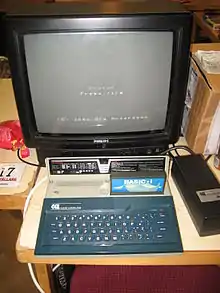Sord M5
The Sord M5 is a home computer launched by Sord Computer Corporation in 1982. Primarily the Sord M5 competed in the Japanese home computer market. It was also sold as the CGL M5 in the United Kingdom by Computer Games Limited and was reasonably popular in Czechoslovakia, where the M5 stood as one of the first affordable computers available to the general public. Takara also sold models in Japan as the Game M5, and models were also exported to South Korea.
 Sord M5 | |
| Developer | Sord Computer Corporation |
|---|---|
| Release date | November 1982 |
| Introductory price | ¥49,800 £195 ₩266,200 |
| Operating system | BASIC-F, BASIC-G, BASIC-I |
| CPU | Zilog Z80A @ 3.58MHz |
Original models of the Sord M5 are relatively small by home computing standards, with a built-in keyboard with rubber keys, similar to the ZX Spectrum, which is also sold in many countries such as the United Kingdom itself, Ireland, Spain, the Netherlands, Singapore, Sweden, Norway, Denmark, Canada, New Zealand, Greece, and Hong Kong as the Sord M5 Creative Computer, which included a carrying case for the computer. The specifications of the computer are very similar to the MSX, a computer that likely forced the Sord M5 (along with many similar Japanese computers) out of the market by the mid-1980s.
The CGL M5 was released in the UK with an introductory price of £195, higher than many of the system's competitors including the ZX Spectrum, and Commodore VIC-20. Whereas the M5 contained a cartridge slot in an age where most computers were using compact cassettes or floppy disks, the small amount of built-in RAM led to few games being produced for the system.
In South Korea, three electronics companies released different personal computers based on Sord M5. The FC-150 was produced and released by LG, Samsung released the SPC-500, and the TommyCom was manufactured and launched by Koryo Systems. These computers supported the Korean alphabet, Hangul. The system specifications of these computers were identical to the original M5, but they had differently shaped cartridge slots. Cartridges from the Sord M5 or other manufacturers could not be used for these computers directly. LG released some original software including several educational programs and games.
Despite its short production run, the M5 was supported by various big Japanese game developers such as Namco and Konami.
Other models include the M5 Pro and M5 Jr.
Technical specifications

Internal hardware
- CPU: Zilog Z80, 3.58 MHz
- Video Hardware: TMS9918
- 40×24 text (6×8 characters), 224 user defined characters
- 256×192 graphics, 16 colours
- 32 hardware sprites (up to 16×16 pixels)
- Sound Hardware: SN76489
- 3 sound channels
- 1 noise channel
- 6 octaves, 15 amplitude levels
- RAM: 20 KB (of which 16KB is screen memory)
- ROM: 8 KB expandable to 16KB
I/O ports and power supply
- I/O ports:
- TV out
- Video out (phono socket)
- Sound out (phono socket)
- Centronics 16-pin interface
- 8-pin DIN cassette connector
- Power supply: external
Language cartridge options
- BASIC-I
- Integer arithmetic only (16 bit signed)
- BASIC-G
- Graphics and sound functions
- BASIC-F
- Floating point arithmetic
- FALC
- Applications package
Retail price
- UK Retail prices, December 1983 [1]
- Sord M5 plus BASIC-I : £190
- BASIC-G : £35
- BASIC-F : £35
- FALC: £35
References
- Computer & Video Games magazine, December 1983